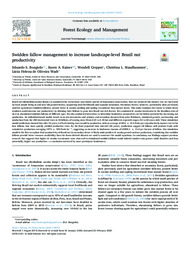Swidden fallow management to increase landscape-level Brazil nut productivity.
Swidden fallow management to increase landscape-level Brazil nut productivity.
Author(s): BONGIOLO, E. S.; KAINER, K. A.; CROPPER, W.; STAUDHAMMER, C. L.; WADT, L. H. de O.
Summary: Brazil nut (Bertholletia excelsa Bonpl.) is considered the cornerstone non-timber species of Amazonian conservation. Nuts (or seeds) of this massive tree are harvested by local people living in and near old growth forests, supporting local livelihoods and regional economies. Secondary forests, however, particularly plots previously used for agriculture (swidden fallows), present better B. excelsa seedling and sapling recruitment than mature forest. This study examines the extent to which forest residents could increase nut productivity by allowing their fallows to grow into Brazil nut rich forests. We conducted B. excelsa inventories in the Brazilian state of Acre in abandoned swidden fallows of different ages. We also conducted interviews to determine landowner perspectives on the fallow potential for increasing nut production. An individual-based model, based on in-situ inventories and primary and secondary datasets from prior fieldwork, simulated growth, survivorship and production from the 250 inventoried trees in 18 fallows of varying sizes (from 0.41 to 4.18 ha) and different regrowth stages (12 to 60 years old). These simulation model predictions showed that after 10 years, 2.4% of existing trees would be productive, with an average of 68.6 ± 21.5 fruits per reproductively mature tree in the four fallows that most quickly yielded productive trees. By the final projected time interval (40 years), predictions suggest all fallows will produce fruits with cumulative production averaging 1475 ± 359 fruits ha?1, suggesting an increase in landowner income of US$55.1 ± 13.4 per hectare of fallow. Our simulation model is the first to explore fruit productivity of Brazil nut in secondary forest. It likely underpredicts B. excelsa growth and nut production, considering that swidden fallows provide better resource availability than the forest-derived datasets we used to construct the model equations. In conclusion, our findings support previous research that suggests that higher B. excelsa recruitment rates observed in abandoned swidden fallows could indeed translate into greater adult densities and thus potentially, higher nut production – a conclusion mirrored by most participant landowners.
Publication year: 2020
Types of publication: Journal article
Unit: Embrapa Rondônia
Keywords: Acre, Amazônia Ocidental, Bertholletia Excelsa, Brazil nuts, Castanha do Para, Castanha do brasil, Crop yield, Nontimber forest products, Plant cultural practices, Pousio, Pratica Cultural, Produto florestal não madeireiro (PFNM), Rendimento, Shifting cultivation, Swidden fallow, Western Amazon
Observation
Some of Embrapa's publications are published as ePub files. To read them, use or download one of the following free software options to your computer or mobile device. Android: Google Play Books; IOS: iBooks; Windows and Linux: Calibre.
Access other publications
Access the Agricultural Research Database (BDPA) to consult Embrapa's full library collection and records.
Visit Embrapa Bookstore to purchase books and other publications sold by Embrapa.

